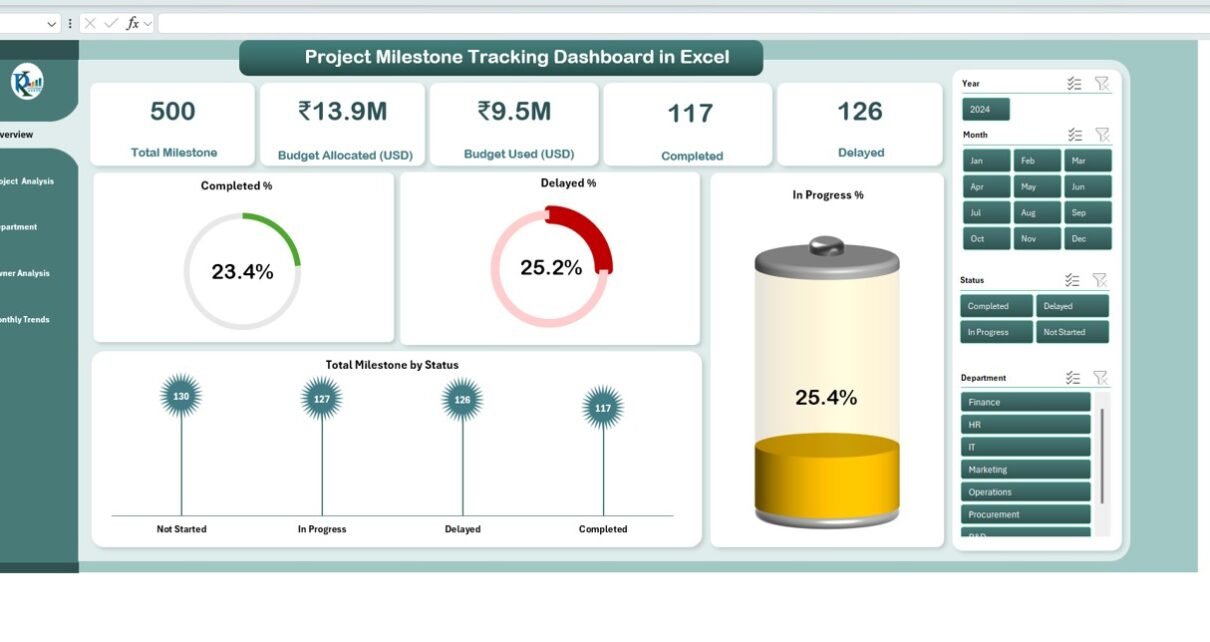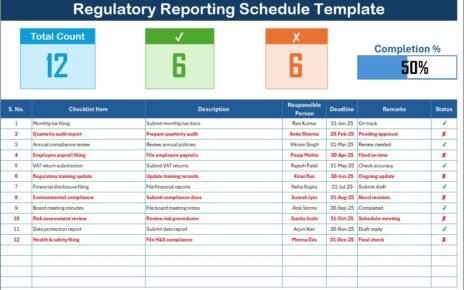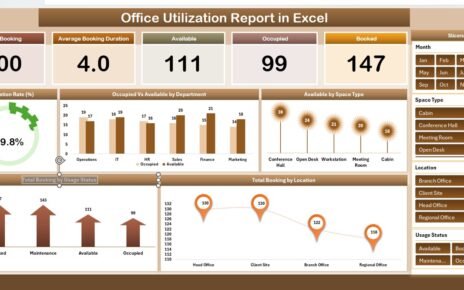Running multiple projects can quickly become overwhelming — deadlines, budgets, and progress percentages all compete for your attention. Without a clear visual system, it’s easy to lose track of where things stand.
That’s where the Project Milestone Tracking Dashboard in Excel comes in — a ready-to-use, fully automated dashboard designed to simplify project management and give you instant visibility into milestones, budgets, and performance metrics.
Whether you manage construction projects, IT implementations, or marketing campaigns, this Excel-based dashboard helps you track milestones efficiently, spot delays early, and make data-driven decisions with confidence.
Click to buy Project Milestone Tracking Dashboard in Excel
What Is a Project Milestone Tracking Dashboard in Excel?
A Project Milestone Tracking Dashboard is an interactive Excel tool that consolidates all your project-related data — including timelines, budgets, owners, and completion rates — into one dynamic interface.
It allows project managers and stakeholders to:
- Track project milestones in real time
- Monitor budget allocation vs. actual spending
- Analyze completion progress by department, owner, or project name
- Visualize monthly trends to identify performance gaps
Instead of using separate spreadsheets and manual updates, this dashboard automatically summarizes everything through charts, slicers, and summary cards — making it an all-in-one project management assistant.
Structure of the Project Milestone Tracking Dashboard
This Excel dashboard comes with five core analytical pages, each offering unique insights into your project portfolio.
Overview Page — The Central Command Hub
The Overview Page gives you a bird’s-eye view of all ongoing and completed milestones. It features:
- Cards showing key metrics:
- Total Milestones
- Budget Allocated (USD)
- Budget Used (USD)
- Completed
- Delayed
- Interactive Charts:
- Completed %
- Delayed %
- Total Milestones by Status
- In Progress %
- These visuals make it easy to identify project performance at a glance. For instance, a sudden increase in the Delayed % chart might indicate resource or scheduling issues that need immediate attention.
Tip: Use Excel slicers to filter data by project, department, or owner — and watch the dashboard update automatically.
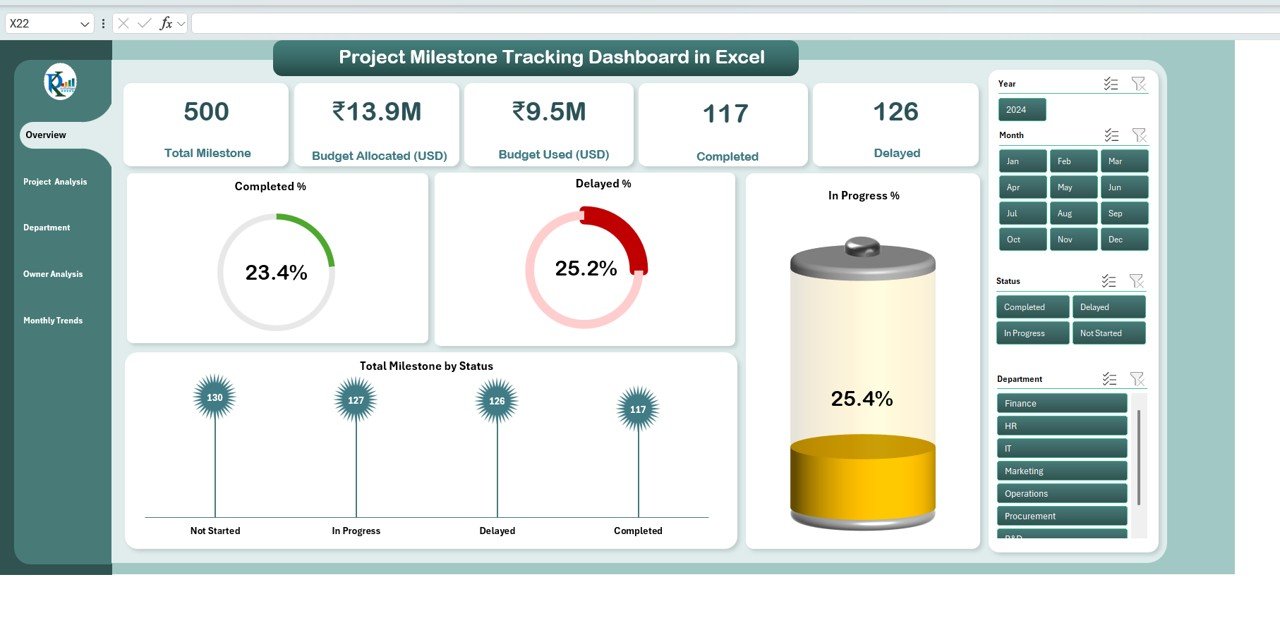
Click to buy Project Milestone Tracking Dashboard in Excel
Project Analysis Page — Deep Dive into Project-Level Performance
This page breaks down performance project by project, offering insights into both financial and progress-based metrics.
Charts and Visuals:
- Budget Used (USD) by Top 5 Projects
- Completed vs. In Progress by Project Name
- Budget Allocated (USD) by Project Name
- Delayed % by Project Name
These visuals help you pinpoint which projects are over budget or behind schedule. The Top 5 Projects chart can highlight where most of your budget goes, helping you assess whether those investments deliver expected outcomes.
Example Insight:
If “Project Phoenix” shows 80% budget utilization but only 45% completion, it’s a sign of inefficiency or potential risk that should be investigated.
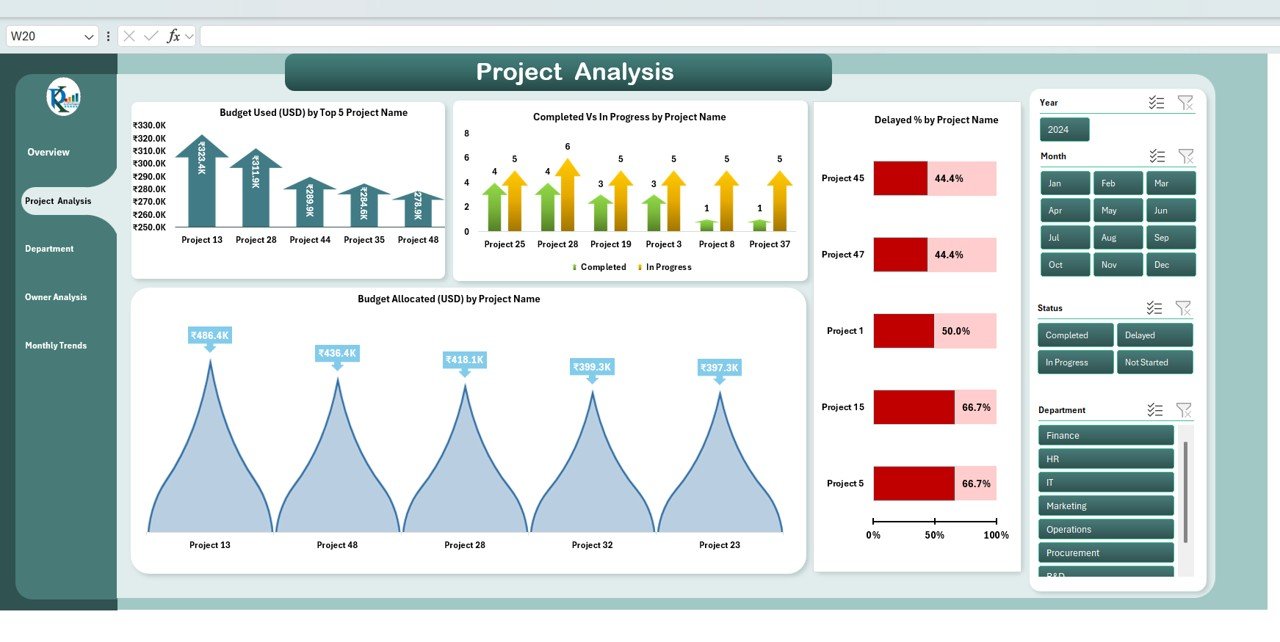
Click to buy Project Milestone Tracking Dashboard in Excel
Department Analysis Page — Measure Team Performance
Projects often span multiple departments. This page provides a breakdown of performance by department to see which teams are meeting deadlines and managing budgets effectively.
Chart Included:
- Completed vs. In Progress by Department
- Budget Used (USD) by Department
- Budget Allocated (USD) by Department
- In Progress % by Department
The Completed vs. In Progress chart visually compares departments’ efficiency levels. If the Finance Department consistently shows a lower completion rate compared to Operations, management can quickly identify bottlenecks or reallocate resources.
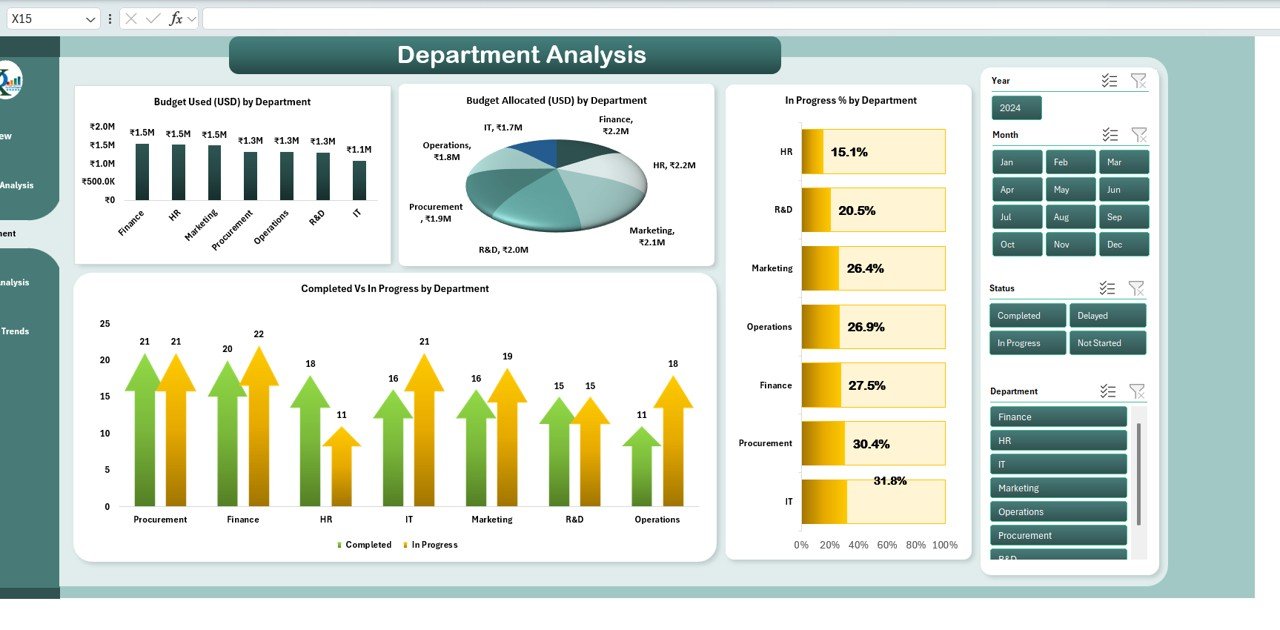
Owner Analysis Page — Accountability and Leadership Insights
This section focuses on project owners or managers. It helps leadership teams monitor who is responsible for which milestones and how well each project owner performs.
Charts Displayed:
- Completed vs. In Progress by Owner
- Budget Used (USD) by Owner
- Budget Allocated (USD) by Owner
- Completed % by Owner
Tracking at the owner level ensures accountability and transparency. You can easily identify high-performing managers or provide additional support where completion rates are lagging.
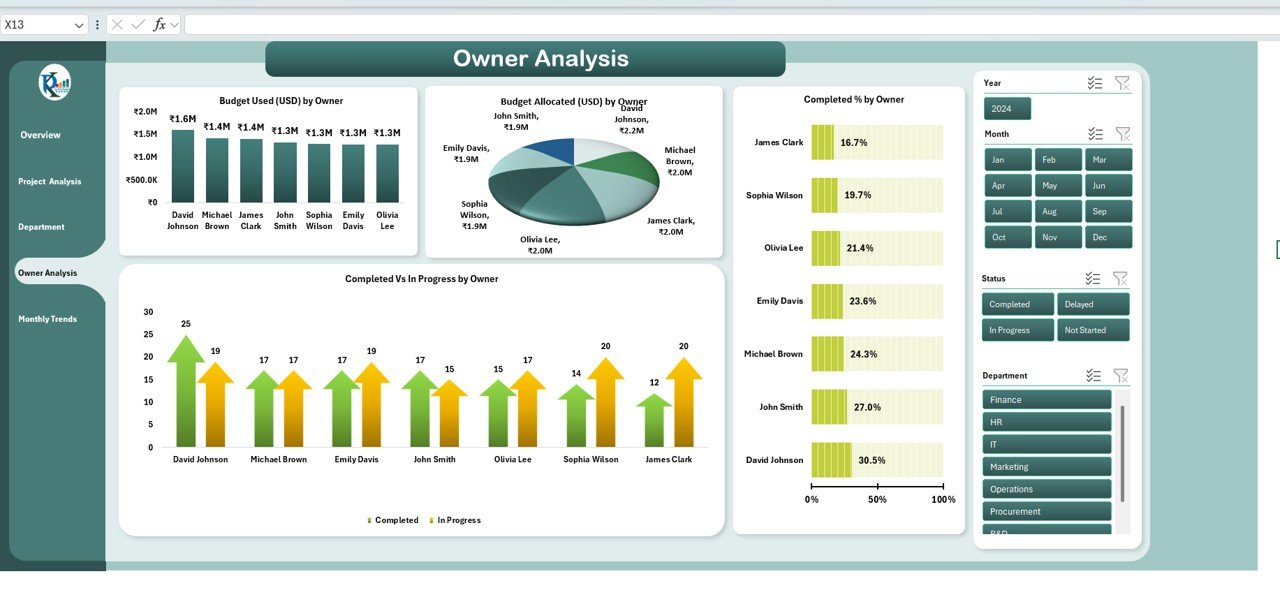
Click to buy Project Milestone Tracking Dashboard in Excel
Monthly Trends Page — Time-Based Performance Visualization
This final page captures performance over time, offering a historical perspective that helps identify trends and predict future performance.
Charts Featured:
- Completed vs. In Progress by Month
- Total Milestones by Month
- Budget Used (USD) by Month
- Delayed % by Month
This time-series data reveals how seasonal trends or workload fluctuations affect project outcomes. For example, if delays consistently spike in Q3, you might adjust scheduling or staffing strategies for next year.
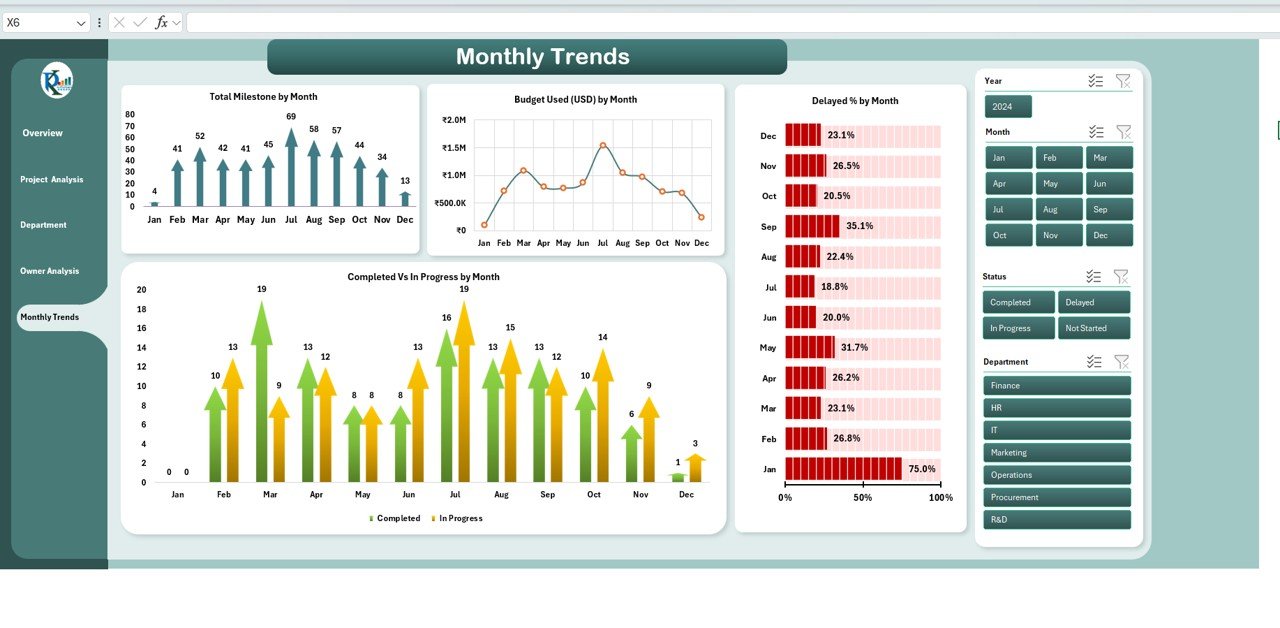
Why Use a Project Milestone Tracking Dashboard in Excel?
Because Excel remains one of the most accessible and flexible tools for professionals. You don’t need expensive software or a steep learning curve. With a few clicks, you can start tracking, analyzing, and visualizing key metrics using your existing data.
Key Benefits:
- Ease of Use: Simple setup with automated charts and slicers
- Comprehensive Insights: Real-time visibility into budgets and timelines
- Cost-Effective: No subscription fees or complex installations
- Customizable: Add or modify fields to suit any industry
- Data-Driven Decisions: Quickly identify problem areas and take corrective action
How the Dashboard Works
Here’s how the system functions behind the scenes:
- Data Input Sheet:
You record all project data — including Project Name, Department, Owner, Budget, Status, and Milestone Details. - Dynamic Calculations:
Built-in formulas automatically calculate percentages, variances, and totals. - Dashboard Pages:
Data flows seamlessly to the dashboard pages, updating charts and cards instantly. - Slicers and Filters:
Use dropdowns and slicers to filter data by project, department, or time period.
This setup eliminates manual reporting, reducing human error and ensuring up-to-date reporting every time.
Advantages of the Project Milestone Tracking Dashboard in Excel
Using this dashboard gives you both clarity and control over your project ecosystem. Let’s explore the major advantages:
- Real-Time Progress Monitoring
Instantly see which milestones are on track, delayed, or completed. The charts automatically refresh when new data is entered.
- Budget Control
Compare Budget Allocated vs. Budget Used to prevent cost overruns and optimize resource allocation.
- Departmental and Owner Accountability
Each department and project owner’s performance is visible through KPIs, ensuring accountability and transparency.
- Improved Decision-Making
By identifying trends early, managers can make informed decisions to reassign tasks or adjust deadlines.
- Visual Storytelling
Color-coded visuals, progress bars, and charts turn raw numbers into actionable insights that are easy for everyone to understand.
Opportunities for Improvement
While the dashboard is robust, you can further enhance its functionality with a few advanced Excel features:
- Add Gantt Charts: Visualize milestones across a timeline for better scheduling clarity.
- Incorporate Conditional Formatting: Highlight delays or over-budget items automatically.
- Integrate with Power Query: Automate data refresh from multiple sources.
- Use VBA Macros: Create buttons to navigate between pages or auto-generate reports.
- Link with Power BI: For advanced analytics and real-time dashboards accessible via cloud.
These add-ons can turn your Excel workbook into a full-fledged project management intelligence tool.
Best Practices for the Project Milestone Tracking Dashboard
To get the most out of your Excel dashboard, follow these best practices:
- Keep Data Consistent
Use dropdown lists for status (Completed, In Progress, Delayed) to maintain consistency.
- Update Regularly
Schedule data entry updates weekly or biweekly to ensure insights stay relevant.
- Validate Data Inputs
Use data validation to prevent errors in project names, owners, or budget entries.
- Monitor Key Metrics Only
Avoid clutter by focusing on 10–15 key KPIs that truly affect project outcomes.
- Backup and Version Control
Save backup versions periodically to avoid data loss or accidental overwriting.
- Communicate with Stakeholders
Share the dashboard during meetings to encourage transparency and collaboration.
Real-World Use Cases
The Project Milestone Tracking Dashboard in Excel fits perfectly in several scenarios:
- Construction Industry: Monitor project phases, contractor performance, and budget allocation.
- IT Projects: Track software development milestones, sprint progress, and deployment delays.
- Marketing Campaigns: Analyze campaign launches, spending efficiency, and on-time deliverables.
- Education Sector: Track institutional improvement plans or research projects.
- Corporate Operations: Manage multiple cross-functional projects with unified reporting.
How to Use This Template
- Download the Template (available on NextGenTemplates.com).
- Open the Data Sheet and input your project details.
- Navigate through pages like Overview, Project Analysis, or Department Analysis.
- Use slicers to filter data by department, project, or owner.
- Analyze charts to monitor progress and identify areas for improvement.
That’s it — no coding or advanced training required.
Conclusion
The Project Milestone Tracking Dashboard in Excel is more than just a reporting tool — it’s a strategic command center for managing projects of any scale. By centralizing your data, it provides instant clarity on progress, costs, and accountability.
With automated insights, interactive visuals, and flexible customization, this dashboard empowers project managers to move from reactive problem-solving to proactive planning.
Whether you’re leading one project or fifty, this Excel dashboard helps you stay organized, informed, and ahead of schedule.
Frequently Asked Questions (FAQs)
- What is the purpose of a milestone tracking dashboard?
It helps project managers monitor milestones, budgets, and progress visually — making it easier to detect delays and stay within budget.
- Can I customize the dashboard for my organization?
Yes! You can modify fields, add new departments, or adjust formulas based on your organization’s needs.
- How often should I update the data?
Ideally, update it weekly or after every milestone review to ensure accurate reporting.
- Do I need Excel skills to use this dashboard?
Basic Excel knowledge is enough. All formulas and visuals are prebuilt and automated.
- Can I share this dashboard with my team?
Absolutely. It’s fully shareable — you can save it on a shared drive or cloud platform like OneDrive for collaboration.
- Does it work on Mac?
Yes, it works perfectly on both Windows and Mac versions of Microsoft Excel.
Visit our YouTube channel to learn step-by-step video tutorials
Watch the step-by-step video tutorial:
Click to buy Project Milestone Tracking Dashboard in Excel
